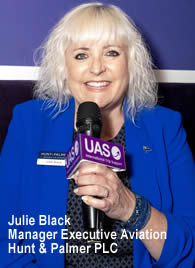UAS International Trip Support turned the spotlight on air charter during one of its Forward Discussion Panels at the recent EBACE Show in Geneva.
Brilliantly chaired by WINGX’s Richard Koe, experts concurred that once charter has been experienced clients tend to get addicted. Business aircraft are getting bigger, charter prices are rising and contrary to perception, traffic is falling off a little now the airlines are back. The Middle East has a business aircraft shortage for charter.
Charter, or on demand aviation, comes in many shapes and sizes. Some sectors are doing exceptionally well, others less so, highlighted international charter brokerage Hunt & Palmer’s Julie Black. “We experienced an incredibly strong Q1 in our executive aviation business and hope it will continue throughout the summer,” she said.
“The music touring business is extremely busy for our commercial team. The demand to see live shows means we are struggling to secure charter capacity, just as there is a shortage of venues to fulfil the demand. Cargo activity, in contrast to the (pandemic) boom of shifting PPE and freight which couldn’t get on ships, has slowed.”
2022 was definitely the best ever year for business aviation – the best I’ve seen in 30 years in the business, concurred George Galanopoulos, Chairman and Managing Director of Luxaviation UK. “We are now somewhere in the middle of a bumper year compared with the 2019 performance for the group,” he said.

(L to R): Richard Koe, WINGX | Gus Paterson, Pula Aviation Services/ CentreLine | Doug Golan, Private Jet Card Comparisons | Julie Black, Hunt & Palmer | George Galanopoulos, Luxaviation UK | Ammar Al Mahmoud, VP of Sales, UAS International Trip Support.
Newcomers who came into charter when the airlines paused are still chartering and nowadays the trend is toward larger cabin size aircraft.
Gus Paterson, COO of Pula Aviation Services and Centreline highlighted that two or three years ago trips would have been on a Citation CJ or CJ2. “We are now doing those same trips on the Legacy 500 – same customers, bigger aircraft.”
The AOC side of its business is important, but Gus attributes his company’s success to the diversity of its operations – in aeromedical capability, MRO, aircraft sales and parts supply. For a smaller operator the secret is to identify one or two aircraft types and specialise.
“Our target is the Gulfstream G550, Legacy, Praetor 500/600, now we have exited light jets.”
The rise of the Jet Card and pre-paid hours are adding to demand. Jetcard subscribers are consolidating their number of trips, but they aren’t cutting back on the amount they spend, according to Doug Gollan, Founder of Private Jet Card Comparisons. Clients are more likely to use business aircraft for special occasions, now the airlines are back. Clients living in a big city like Miami can take a scheduled flight nonstop, anywhere. Others in outlying areas (in spoke cities) however, face the prospect of a two day wait for the next flight if their scheduled connection gets cancelled. Business aviation is attractive, because commercial airlines still aren’t meeting their needs, he said.
Referring to his latest survey, Doug highlighted 95% of people turning to private aviation were continuing their habit. 40% of respondents (down from 60%) replied they would be flying privately regularly in the future – citing trips with family members, pets. Solo travellers, minus checked luggage, are going back to the airlines, he highlighted.
In the Middle East, however, there is a shortage of capacity, with fewer charter aircraft based in the region, according to UAS International Trip Support’s Ammar Al Mahmoud, VP of Sales.
“The number of Dubai and Saudi operators diminished during the pandemic with operators letting their AOCs go, or selling their aircraft.,” he said. Moreover, the region is more focused onprivately managed aircraft – for Family Offices, Royal families and Government transport. This lack of competition means the cost of a Boeing Business Jet charter from Dubai or Riyadh to London is now much higher. “We are hopeful to see more AOC operations from the Middle East this year,” said Ammar. The scarcity is putting more clients on commercial (first class cabins) he noted.
What about quality of aircraft supply?

“We always work with operating partners we trust, who offer a professional service with well-maintained aircraft,” said Hunt & Palmer’s Julie Black. Pricing has definitely increased. “We have clients who make the same trip every year and there has been staggering (price) increases over the last 10 years. Nowadays, too, business aircraft owners who offer their aircraft up for charter, are more inclined to keep their assets for their own use. It’s a challenge, especially when we’re invariably required to sign contracts in advance to get owner approval – which can be frustrating for clients.” This is especially prevalent in the USA. “We do work with consolidated operators who can be quicker to respond, their aircraft not subject to owner approval. This is really changing the market dynamic now,” she said.
The consolidation factor among operator groups is creating big fleets of aircraft, which aids optimisation, the panel observed. Whilst homogenization is a good thing, we risk de-personalizing and I’d like to see operators continuing to retain their identity and individuality. That’s really important because it’s something that as a broker we sell. And the experience that keeps people coming back to what we do. “We’ve got to keep delivering a good service so clients referring newcomers to us and we can keep amazing operators busy and keep the great cycle going.”
Certainly, in the small aircraft charter arena the marketplace is more competitive, price sensitive and this is the usual entry point for newcomers to business aviation.
Charter customers are definitely trading up, added Gus Paterson. We’ve got a couple of management clients who come to us because we have an aeromedical capability. We can put a paramedic on the aircraft, which other operators can’t.
We will continue to welcome new clientele, said George Galanopoulos. The YouTubers/influencers, who aren’t ashamed to be seen on a jet. These people are becoming increasingly wealthy, and are set to be our future clients.
The big challenge we all face is sustainability, he noted. “We are late to embrace it, we should have been on it two or three years ago. We are not doing enough to raise our profile to actually tell people what we’re doing. Fact is – we are doing an awful lot as an industry, versus a lot of other industries who haven’t done as much as we have.”
Doug Gollan agreed. “The industry is just going to go from strength to strength. There will always be headwinds, but I’m very optimistic and I think, the consumers who got into private aviation, because of Covid, liked what they saw. They get addicted.” We should keep looking forward and try not to listen to the noise.
One of the things the industry can talk more about is how much these people flying privately are bringing into the local economies. The average spend when a private jet comes to a destination is over $80,000 (and that was a calculation 10 years ago). One private jet can contribute as much revenue generation as a B737, he concluded.
